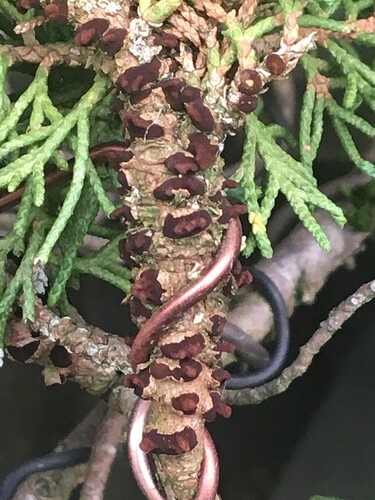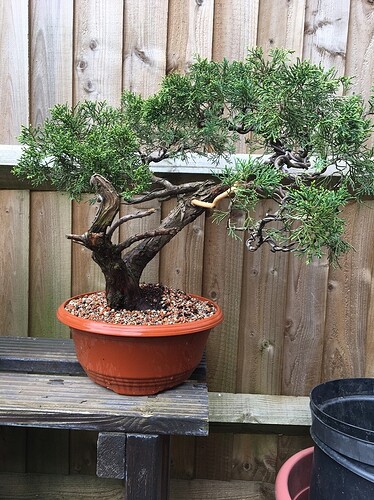Anyone any idea what this is ? It’s all over my juniper around the junctions. the foliage seems fine. A number of other people in the UK have also been posting about it but I’ve not seen an identification yet. I’ve started spraying with fungicide for now.
Hi @Gary.Jones
I have had this on my juniper in U.K. as well. Forget what it’s called but really scary when it rains and the brown blobs expand and become jellatenus. Think it’s apple rust. Cut out the effected areas and look after balance of water and oxygen. My junipers are better this year.
yes it is for sure European pear rust.
It is really hard to get rid off. Check if you have a pear tree near by.
The pear tree is infecting the juniper in spring.
Only way to handle this is to eliminate the pear tree which most of the times is not possible.
This is rust, and was covered in the forum Q+A 9 51 mins in. Rust has three forms, that have three different pairing host trees. All are rosacae family, so firstly cut off all the parts of you juniper that have the infection, bag it and get rid of it. The glelatinous stage is just before it releases loads of spores to infect the pairing host plant.
You will need to spay with Bordeaux mix (copper sulphate in suspention) the pairing host tree to stop it being infected to perpetuate the cycle. The pairing hosts are crab apple… i forget the others. But goggle it. The one my friend had was red, and linked to a crab apple overhanging from the neighbours garden!
Just been out back to look at the junipers, and the rust is back on Sabinas but not Shimpakus. Iv cut it off. I will NOT be getting rid of pear and apple trees, or any of the other 2,500 species in the rose family!
I was not advocating getting rid of anything. I was saying that if you want to control it then you will need to stop the cycle of the fungal pathogen from host to juniper back to its host. This can be done by removing it as it spores from your juniper and then using bordeux mix as a spry on the host plant to stop the spores from taking on the other host. So you need to identify what the other host plant is. As i said my friend has a lot of very valuable junipers and the second host is in his neighbours garden… Bordeaux mix is cheep and not massivly detrimental. And if you have a problem with peach leaf curl it should sort that too. Using a non selective anti fungal agent could give you many more problems as we really want the microrhizal growth in our bonsai pots.
Thanks @Robin,
I think it was @svencux that was advocating the removal of hosts. My point is it appears to be almost impossible (without access to a laboratory) to identify the host, and its clear that even though the rust is identified with the rose family, it’s clear that it is not confined to it, as we find it on juniper. I will definitely be looking for some Bordeaux mix.
If you have hawthornes, blackthornes, plum, or mama, or malus then give them a tinkle with the mix, but if the leaves are out it is to late. I susspect it will be a bigger normal tree near by. Just keep a look out for deformed leaf growth around your garden over the next year. Atleast you wont get peach leaf curl. I am not sure when the transmition comes back to junipers. I would susspect it will be in the autumn, at leaf fall, so possibly give your junipers a spray then to disrupt the fungal spores then too.
This looks like what we call “cedar-apple rust” in the U.S. If you google cedar apple rust you will see all sorts of information and treatment options. Basically the fungal disease alternates between juniperus species and apple and other rosaceae species. The orange masses on the juniper release spores that infect the apple tree in the spring, then the infection on the apple tree releases spores that go back and infect the juniper. The only way to cure is to interrupt the life cycle.
I have been to my local garden centre (UK, and still part of EU), and they told me that they have not been allowed to sell Bordeaux mix for about the last 4 years. I picked up some copper fungicide and now need some hydrated lime to make my own. However, internet is giving me different ratios of copper, lime and water. 1:1:100, or 10:10:100? Any thoughts? I’m planning on the weaker mix.
No… i will get back to you… i got some copper stuff that is supposed to be the same as bordeaux mix… i will take a look tomorrow…
Thanks to all for the thoughts and ideas. I ended up cutting off all the infected areas and binning them which involved at least a third of the foliage. This was followed by a restyle to make the tree presentable again making use of what was left. This poor tree has really been through the wars - when I got it it had suffered from some sort of tip damage (possibly zealous pinching by the previous owner?) and is still not fully recovered from that. However it’s clear of rust for now and I’ve placed it elsewhere in the garden to reduce the likelihood of reinfection and will monitor the pear tree as well.
Best thing maybe to just let it get strong again before fiddling with it too much?
I inspected my junipers and found 2 branches on a tree also infected. i removed them and hope (this is my first year with akadama/pumice,lava-soil and organic fertilizer) that the health of my trees improve. Advices from the forum are very helpfull to me. Thank you guys.
Mark
Yesterday I received a large shohin itoigawa juniper, unfortunately I didn’t know about rust fungus. I’m worry because I have two Nagasaki crabapples… Any advice?
I would say the best advice is to be very vigilant. I have had a small touch of this. A few leaves on a hawthorn last year which I got rid of immediately. This year I had 2 blobs on a juniper and cut them off straight away. They literally came up overnight after a storm. Nothing since and I inspect everything a number of times each day. I have sprayed with mancozeb on the advice of a mate who has also suffered. His are under control now.
My jellies appeared in mid spring, the hawthorn leaves were in the summer.
Thx u Blown, how about ways to prevent? I try to keep them separate but apparently will not make much difference in a medium size garden, so yesterday, following RHS recommendation on apple rust, I bought Bayer Fungus Fighter Concentrate. When would be the must effective time to prevent that cycle? Any comments?
P.S text edited before reply, sorry!
I started spraying in April and will carry on until I see no problems on my hawthorns or apples. Both trees that were affected in my garden had been with me ofr a number of years with never a problem before. This makes me feel that we are always vulnerable as the spores can travel miles apparently. I found a map of the UK spread of this issue and it showed that my area is affected. I assume now that my problem was blown in.
Can I see the map plz?
I stumbled across it when I was researching on Google a few months back. Will have to dig it out again.

